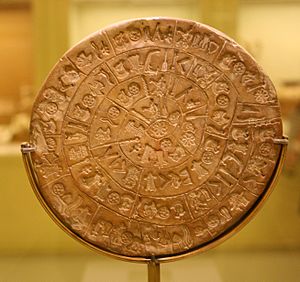Hieroglyph facts for kids
Hieroglyphs are a special kind of writing that uses symbols or pictures instead of letters. These pictures can stand for sounds, words, or ideas. Ancient cultures like the Egyptians, Luwians, and Mayans used hieroglyphs. You can also find examples in places like Turkey, Crete, the United States, and Canada.
People think hieroglyphs started when pictures were used to tell stories on pottery and other art. Over time, these pictures slowly changed into a form of writing.
The word hieroglyph comes from two ancient Greek words: hierós (meaning 'sacred') and glúphein (meaning 'to carve' or 'to write'). The ancient Greeks who visited Egypt saw these picture letters carved on house walls, tombs, and large monuments.
Contents
Ancient Egyptian Hieroglyphs
Ancient Egyptians used pictures to create a phonetic alphabet. This means each picture stood for a sound, much like a rebus puzzle. For example, a zig-zag picture that looked like water came to mean the letter "n". This was because the Egyptian word for water started with the "n" sound. Interestingly, this same picture later became our letter 'M' in the Latin alphabet. This happened because Semitic workers changed the symbols to fit sounds in their own language, and their word for water started with 'm'.
In a similar way, our Latin letter 'N' came from the hieroglyph for a snake. In Egyptian, this snake picture stood for a sound like the English "J." Some pictures also represented whole ideas, and these are called ideograms.
The Egyptians used about 700 to 800 different pictures, or glyphs. They wrote from right to left and from top to bottom. They did not use any punctuation marks.
The History of Egyptian Hieroglyphs
Archaeologists believe Egyptians started using hieroglyphs around 3300 or 3200 BCE. They were used for more than 3,500 years! Only important people like nobles, priests, and government officials knew how to write in hieroglyphs. They were difficult to learn and took a long time to carve or write.
People slowly stopped using hieroglyphs when Christianity became popular in Egypt. The last known hieroglyphic writing was made in 394 CE.
Like Japanese or Chinese characters, Egyptian hieroglyphs began as pictures that represented ideas. This ancient writing system did not use vowels; all the sounds written were consonants.
How the Code Was Broken
After the end of the Egyptian civilization in 30 BCE, no one remembered how to read hieroglyphs. This changed in 1798 when French soldiers took over Egypt. They found a large stone, which is now famous as the Rosetta Stone.
The Rosetta Stone had the same message written in three different languages: hieroglyphs, Ancient Greek, and demotic. Demotic was a simpler form of hieroglyphs. Jean-François Champollion was a French scholar who guessed that the writing on the stone was the same in all three languages. By using the Ancient Greek text, he was able to figure out the name of the ruler, Ptolemy V Epiphanes, in hieroglyphs. After many years of hard work, he finally learned how to read all the other words.
Cretan Hieroglyphs

Another type of hieroglyphs was used on the island of Crete and nearby islands around 2000 BCE. This writing system later developed into a script called Linear A. For a while, both writing systems were used at the same time.
Out of 137 known symbols, many look like pictograms (pictures). About 96 of these hieroglyphs appear in "words," and 32 seem to be logograms (symbols that represent whole words).
There are also four numerals that stand for 1, 10, 100, and 1000. A small cross symbol probably shows where the text begins. Because there are not many symbols, this writing is likely syllabic. This means each symbol stands for a syllable, similar to Linear A. Most of the known texts are short and found on sigils (seals) and clay pieces.
Images for kids
-
Egyptian hieroglyphs typical of the Graeco-Roman period, carved in relief. These glyphs show a viper, an owl, a 'bread bun', and a folded cloth.
See also



